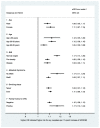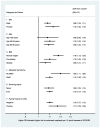Cardiovascular Risk Assessment by SCORE2 Predicts Risk for Colorectal Neoplasia and Tumor-Related Mortality
- PMID: 35629269
- PMCID: PMC9146398
- DOI: 10.3390/jpm12050848
Cardiovascular Risk Assessment by SCORE2 Predicts Risk for Colorectal Neoplasia and Tumor-Related Mortality
Abstract
Objectives: The European Society of Cardiology endorsed SCORE2 to assess cardiovascular risk. The aim of this observational, retrospective study was to assess whether SCORE2 is associated with colorectal neoplasia in an asymptomatic screening population. Further, we evaluated if SCORE2 predicts tumor-related mortality. Methods: We included 3408 asymptomatic patients who underwent a screening colonoscopy. We calculated SCORE2 for each participant and stratified patients according to their predicted 10-year risk of cardiovascular disease: SCORE2 0−4.9%, SCORE2 5−9.9%, and SCORE2 ≥ 10%. We assessed the association between SCORE2 as a continuous variable, the presence of colorectal neoplasia using multilevel logistic regression, and SCORE2 and mortality using Cox regression. Results: In total, 1537 patients had a SCORE2 of 0−4.9%, 1235 a SCORE2 of 5−9.9%, and 636 a SCORE2 ≥ 10%. The respective rates of colorectal neoplasia were 20%, 37%, and 44%. SCORE2 was associated with the presence of any (OR 1.11 95%CI 1.09−1.12; p < 0.001) and advanced colorectal neoplasia (OR 1.06 95%CI 1.08−1.13; p < 0.001) in univariate analysis. After multivariable adjustment (age, sex, family history, and metabolic syndrome) a higher SCORE2 remained associated with higher odds for any (aOR 1.04 95%CI 1.02−1.06; p = 0.001) and advanced (aOR 1.06 95%CI 1.03−1.10; p < 0.001) colorectal neoplasia. SCORE2 was associated with both all-cause (HR 1.11 95%CI 1.09−1.14; p < 0.001) and tumor-related mortality (HR 1.10 95%CI 1.05−1.14; p < 0.001). Conclusions: We found that SCORE2 is associated with the presence of colorectal neoplasia. Clinicians could kill two birds with one stone calculating SCORE2. In patients with a high SCORE2, screening colonoscopy aside from cardiovascular risk mitigation could improve outcomes.
Keywords: cancer screening; colorectal adenoma and carcinoma; primary prevention; risk assessment; risk score.
Conflict of interest statement
The authors declare that they have no known competing financial interests or personal relationships that could have appeared to influence the work reported in this paper. However, the following author discloses a conflict of interests outside the submitted work: C.D. is part of the scientific advisory board of SPAR Österreich AG.
Figures





References
-
- GBD 2019 Demographics Collaborators Global age-sex-specific fertility, mortality, healthy life expectancy (HALE), and population estimates in 204 countries and territories, 1950–2019: A comprehensive demographic analysis for the Global Burden of Disease Study 2019. Lancet. 2020;396:1160–1203. doi: 10.1016/S0140-6736(20)30977-6. - DOI - PMC - PubMed
-
- Niederseer D., Bracher I., Stadlmayr A., Huber-Schönauer U., Plöderl M., Obeid S., Schmied C., Hammerl S., Stickel F., Lederer D., et al. Association between Cardiovascular Risk and Diabetes with Colorectal Neoplasia: A Site-Specific Analysis. J. Clin. Med. 2018;7:484. doi: 10.3390/jcm7120484. - DOI - PMC - PubMed
-
- Gini A., Jansen E.E.L., Zielonke N., Meester R.G.S., Senore C., Anttila A., Segnan N., Mlakar D.N., de Koning H.J., Lansdorp-Vogelaar I., et al. Impact of colorectal cancer screening on cancer-specific mortality in Europe: A systematic review. Eur. J. Cancer. 2020;127:224–235. doi: 10.1016/j.ejca.2019.12.014. - DOI - PubMed
Grants and funding
LinkOut - more resources
Full Text Sources
Medical

